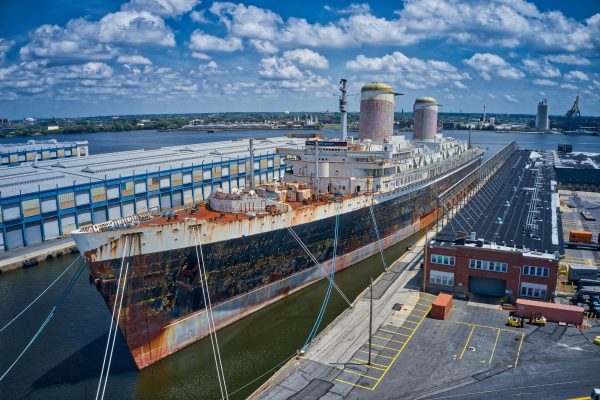
In a year and a half, the United States Coast Guard and officials from Okaloosa County, Florida, will intentionally sink the last ocean liner in the United States. The SS United States, a 1,000-foot, 53,000 ton behemoth, still holds the trans-Atlantic speed record.
On July 7, 1952, the SS United States broke the record in three days, 10 hours and 40 minutes. This beat the previous record by 10 hours. Four former presidents sailed on the historic ocean liner: Harry Truman, Dwight Eisenhower, John Kennedy and Bill Clinton. Additionally, Leonardo da Vinci’s “Mona Lisa” sailed on the ship in 1963.
Now, after years of service as an ocean liner and a museum ship, the SS United States will be sunk off the coast of Destin-Fort Walton Beach, Florida to become an artificial reef. Officials hope the reef will bring in millions of dollars in tourism through spending in scuba shops, chartering boats and hotels.
For coastal researchers in Louisiana, like Henry Bart, professor in the School of Science and Engineering, this development allows for new research opportunities. Bart specifically works in Tulane University’s Department of Ecology and Evolutionary Biology; he also directs the Biodiversity Research Institute in Belle Chase, Louisiana.
“Marine scientists like to study the kinds of organisms that colonize those artificial reefs, so that they can plan … and implement different designs of artificial reefs. It’s going to help to improve that. It’ll encourage other ships that can be prepared and sunk.”
Bart also described how the new artificial reefs can positively impact fishermen in the area.
“Various kinds of marine invertebrates like corals and sea fans inhabit [reefs]. That attracts fish to those structures, and then little fish attract big fish, and it becomes a resource for fishermen.”
Beyond research, Bart hopes this development will help the Gulf of Mexico for everyone.
“I look at [the reefs] less as places of recreational enjoyment and places where you can go and catch fish, and more as something that’s good for the Gulf of Mexico,” Bart said. “It’s something that’s likely to attract a variety of kind of interests, not just fishermen and divers, but also marine scientists that want to study those organisms and engineers that are learning how to intentionally sink [the ships].”
Days after the announcement, citizens from New York created a petition on change.org to save the SS United States for the purpose of preserving it as a marvel of maritime engineering.
“Deliberately sinking SS United States would constitute dumping for purposes of the Ocean Dumping Act, which requires a permit from the Environmental Protection Agency,” Martin Davies, director of the Maritime Law Center at Tulane University Law School, said. “Because the ship is on the National Register of Historic Places, the EPA is required by law to consider any ‘adverse effects’ the granting of a permit would have on the ship.”
“Not surprisingly, sinking the ship would constitute an ‘adverse effect’ because it would be what the regulations refer to as a change of the character of the property’s use that would affect its historic significance. Because the EPA is required to seek ways to avoid, minimize or mitigate any adverse effects, it is difficult to understand how a permit could properly be granted,” he said.
It remains to be seen how local or federal officials will react to this petition or the plan in general.


